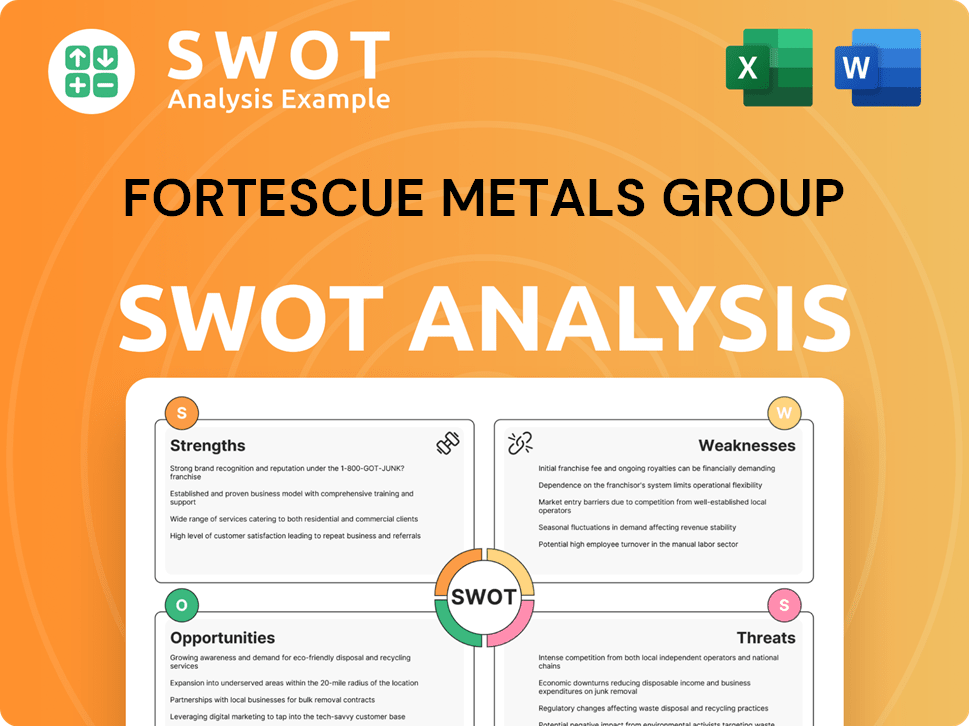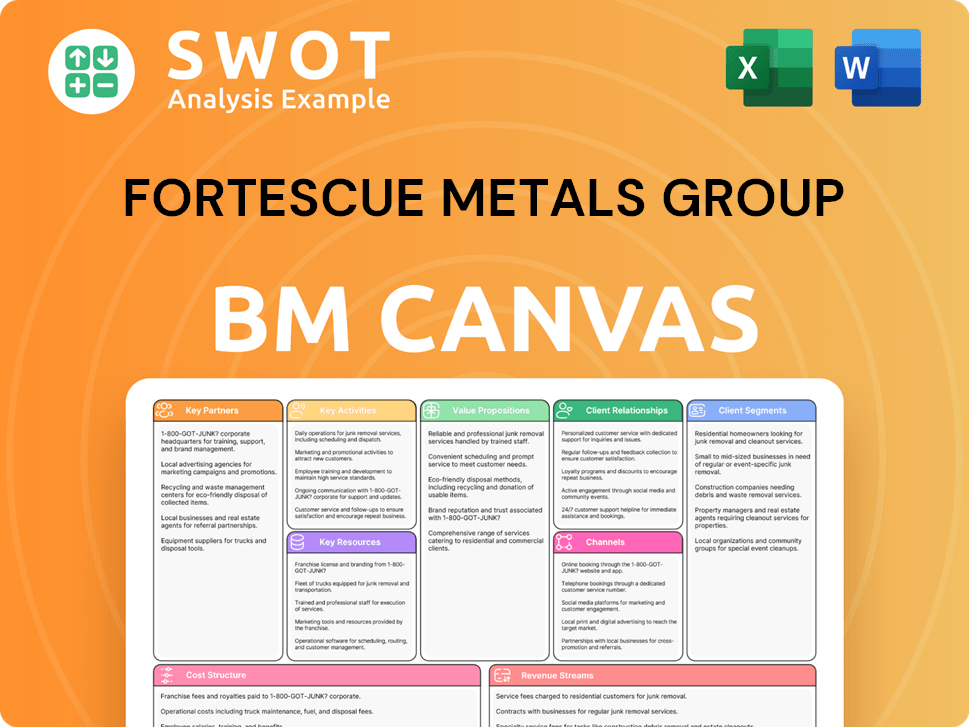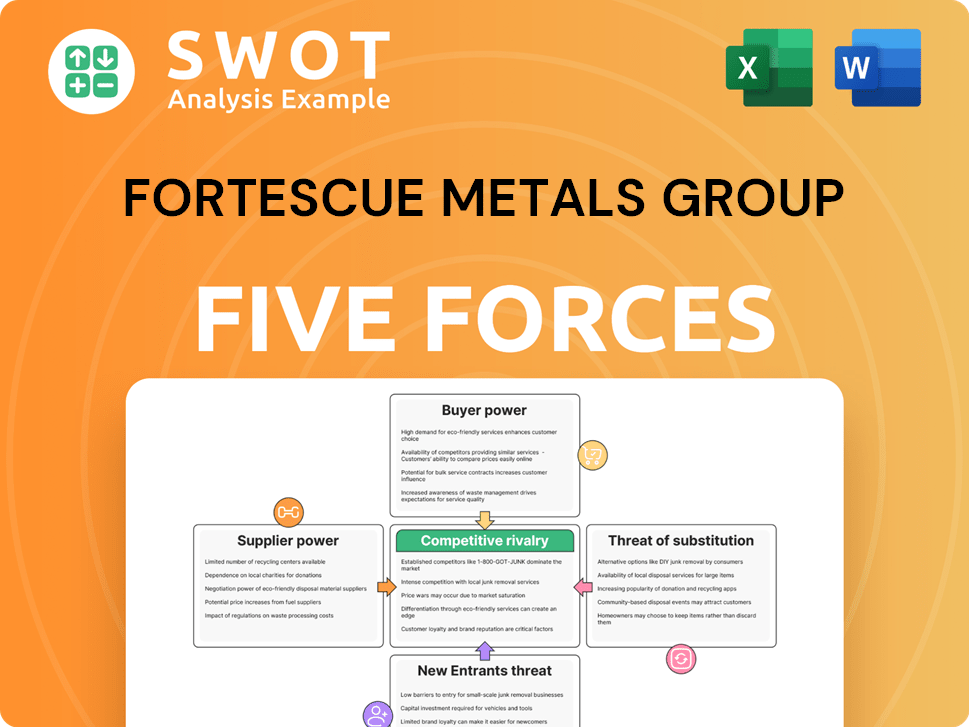Fortescue Metals Group Bundle
How did Fortescue Metals Group rise to global prominence?
Fortescue Metals Group (FMG) isn't just another mining company; it's a story of audacious vision and relentless execution. From its humble beginnings in 2003, FMG, under the leadership of Andrew Forrest, disrupted the iron ore market. This brief history of FMG explores how a company, born from a bold ambition to unlock the Pilbara region's iron ore wealth, transformed the industry.

Fortescue's journey began in Perth, Australia, with a mission to connect untapped iron ore deposits to global markets. The company's commitment to innovation and operational excellence has been a key driver of its growth, and it has become a global leader in iron ore production. For a deeper dive into the strategic landscape, consider exploring a detailed Fortescue Metals Group SWOT Analysis.
What is the Fortescue Metals Group Founding Story?
The story of Fortescue Metals Group (FMG) begins in April 2003. It was founded by John Andrew Henry Forrest, also known as Andrew 'Twiggy' Forrest. He took control of Allied Mining and Processing, which held iron ore rights in the Pilbara region, and rebranded it as Fortescue Metals Group.
The company was created with a bold vision. It aimed to develop a new port and rail system. This system would connect large, previously inaccessible iron ore deposits in Western Australia's Pilbara region. The goal was to supply the growing steel markets in Asia, particularly China. At the time, major producers dominated the industry, leaving the Australian market with significant untapped potential.
Fortescue's initial focus was on solving the infrastructure problem. The company identified a lack of infrastructure to commercialize the 'stranded' iron ore resources. Their business model centered on becoming a 'new force in iron ore'. This involved owning significant iron ore resources and building the infrastructure to bring them to market. This included an innovative exploration model and a focus on developing a new marketable fines product called 'Rocket Fines'.
Fortescue's journey started with the strategic re-purchase of Andrew Forrest's ancestral farmland. The company then quickly acquired significant leasehold in the Pilbara.
- By 2005, Fortescue held over 16,700 square kilometers, making it the largest tenement holder in Western Australia.
- This large landholding positioned Fortescue to grow its activities in one of the world's most important iron ore provinces.
- The Pilbara's strategic location is near the massive East Asian markets.
By 2024, Fortescue's iron ore production reached approximately 182 million tonnes. The company's focus on sustainability and its growth strategy have been key to its success. To gain a deeper understanding of how the company operates, consider reading about the Target Market of Fortescue Metals Group.
Fortescue Metals Group SWOT Analysis
- Complete SWOT Breakdown
- Fully Customizable
- Editable in Excel & Word
- Professional Formatting
- Investor-Ready Format

What Drove the Early Growth of Fortescue Metals Group?
The early growth of Fortescue Metals Group (FMG) was characterized by rapid development and strategic infrastructure investments. Founded in April 2003, the company focused on establishing infrastructure to connect the Pilbara's iron ore deposits. This period saw significant exploration successes and the completion of major projects, setting the stage for substantial iron ore production and expansion.
By 2004 and 2005, Fortescue achieved significant exploration successes in the Chichester Ranges, defining substantial iron ore resources at Cloudbreak and Christmas Creek. A definitive feasibility study for the mine, rail, and port was completed by May 2006. Construction of the integrated rail and port supply chain began in September 2006 after a successful $3.2 billion capital raising.
The Cloudbreak mine and processing plant were completed by April 2008, alongside the Herb Elliott port facility at Port Hedland and a 256 km heavy haul railroad. Mining of overburden started in late 2007 at Cloudbreak, and on May 15, 2008, Fortescue celebrated its 'First Ore on Ship' to China. In its first 12 months of operation, total shipments reached 24.6 million wet metric tonnes.
Fortescue expanded its operations to Christmas Creek in 2009, forming its Chichester Hub with an annual production capacity of approximately 100 million tonnes per annum (mtpa). In August 2004, the company entered a binding deal with China Railway Engineering Corporation (CREC) for the construction of its autonomous train system. In 2009, Hunan Valin Steel acquired a 16.5% stake in Fortescue Metals for US$771 million.
During this period, Fortescue aimed to be the safest, lowest cost, and most profitable iron ore producer, aiming to unlock the potential of the Pilbara region. By 2005, Fortescue moved from a junior explorer to a company listed on the Standard & Poor's ASX 200 Index. For more information on the company's ownership structure, you can read about the Owners & Shareholders of Fortescue Metals Group.
Fortescue Metals Group PESTLE Analysis
- Covers All 6 PESTLE Categories
- No Research Needed – Save Hours of Work
- Built by Experts, Trusted by Consultants
- Instant Download, Ready to Use
- 100% Editable, Fully Customizable

What are the key Milestones in Fortescue Metals Group history?
The journey of Fortescue Metals Group (FMG) has been marked by significant milestones, from rapid project execution to strategic shifts in response to market dynamics. A key aspect of its success has been the ability to develop and commission integrated mining and infrastructure operations efficiently. The company's evolution reflects its commitment to innovation and its adaptability in the face of industry challenges.
| Year | Milestone |
|---|---|
| 2008 | Achieved 'First Ore on Ship' on May 15, just 3.5 years after the Cloudbreak discovery hole. |
| 2011 | Transitioned to reporting revenues of approximately $5.5 billion. |
| 2020 | Commissioned the Integrated Operations Centre, the Fortescue Hive, to enhance supply chain efficiency. |
| 2022 | Acquired Williams Advanced Engineering (WAE), now Fortescue Zero, to develop zero-emission technology. |
| 2025 | Announced a AU$350 million investment in autonomous electric drill rigs. |
Fortescue has consistently embraced innovation to enhance its operations and market offerings. The company developed a new exploration model, pioneered the use of surface miners, and created the 'Rocket Fines' product.
Fortescue developed a new exploration model to identify and assess iron ore deposits more efficiently. This approach has been crucial in expanding its resource base and supporting its growth strategy.
Pioneered the application of surface miners as the main production unit to improve efficiency. This innovative approach significantly increased productivity in its mining operations.
Designed a new marketable fines product called 'Rocket Fines' to optimize its product offerings. This product innovation enhanced its market competitiveness.
Implemented an efficient 'desand' flow sheet for upgrading ore, improving the quality of its iron ore products. This process helped in meeting the specific needs of its customers.
Fortescue was the world's first iron ore company to operate a completely autonomous haulage fleet by 2021. This technology significantly improved safety and efficiency.
In collaboration with WAE, Fortescue is developing the world's first zero-emission electric Infinity Train, which recharges itself using gravitational force. This project underscores its commitment to sustainable practices.
Fortescue has faced challenges, including market fluctuations and the complexities of large-scale projects. The company has responded with strategic pivots, such as the consolidation of its brand and adjustments in its green hydrogen division.
FMG has had to navigate market downturns, which have impacted its financial performance and strategic planning. These fluctuations require adaptability and proactive measures.
Large-scale project development inherently involves complexities, including regulatory hurdles and logistical challenges. Effective project management is crucial for successful execution.
In July 2023, Fortescue Metals Group and Fortescue Future Industries combined under a single brand, 'Fortescue,' to represent a unified global metals and green energy company. This strategic move aimed to streamline operations and enhance market positioning.
In May 2025, Fortescue announced a strategic shift in its green hydrogen division, moving from manufacturing to research and development. This change reflects the evolving landscape of the green hydrogen market.
The shift in the green hydrogen division resulted in approximately 90 job cuts, reflecting the industry's adjustments to commercial realities. This recalibration is a response to challenges in the green hydrogen sector.
Despite these adjustments, Fortescue maintains its commitment to green hydrogen as a core component of its future green iron production strategy. This commitment aligns with its broader sustainability initiatives.
For more on Fortescue's core values and vision, see Mission, Vision & Core Values of Fortescue Metals Group.
Fortescue Metals Group Business Model Canvas
- Complete 9-Block Business Model Canvas
- Effortlessly Communicate Your Business Strategy
- Investor-Ready BMC Format
- 100% Editable and Customizable
- Clear and Structured Layout

What is the Timeline of Key Events for Fortescue Metals Group?
The journey of Fortescue Metals Group, or FMG, since its inception in April 2003, reflects a story of remarkable growth and strategic adaptation in the mining sector. Founded by Andrew Forrest, the company quickly established itself as a major player in the iron ore market. Key milestones include securing a binding deal with China Railway Engineering Corporation (CREC) in August 2004, listing on the ASX 200 Index in 2005, and achieving 'First Ore on Ship' to China in May 2008. Over the years, FMG expanded its operations, opening mines like Christmas Creek and Solomon, and diversified its product offerings. More recently, the company has focused on sustainability and green energy, establishing Fortescue Future Industries (FFI) and investing in projects like the Eliwana and Iron Bridge mines.
| Year | Key Event |
|---|---|
| April 2003 | Founded by Andrew Forrest in Perth, Western Australia. |
| August 2004 | Signed a deal with China Railway Engineering Corporation (CREC) for an autonomous train system. |
| 2005 | Listed on the Standard & Poor's ASX 200 Index and became the largest tenement holder in Pilbara. |
| September 2006 | Project construction commenced following a $3.2 billion capital raising. |
| May 15, 2008 | Celebrated 'First Ore on Ship' to China. |
| 2009 | Christmas Creek mine began production, and Hunan Valin Steel acquired a 16.5% stake. |
| May 2013 | Officially opened its 20 million tonnes per annum (mtpa) Firetail mine at Solomon. |
| December 2013 | Achieved first production from its 40 mtpa Kings Valley mine. |
| May 2018 | Announced US$1.28 billion development of the Eliwana mine, with production expected in 2020. |
| June 2020 | Announced an emissions reduction goal to achieve net-zero operational emissions by 2040. |
| 2020 | Fortescue Future Industries (FFI) was established to lead in green energy development. |
| December 2020 | Eliwana hematite mine opened. |
| March 2022 | Acquired Williams Advanced Engineering (WAE), rebranded as Fortescue Zero, for zero-emission electric Infinity Train development. |
| July 2023 | Fortescue Metals Group and Fortescue Future Industries combined under the single brand 'Fortescue.' |
| July 2023 | Iron Bridge magnetite project shipped its first cargo. |
| January-March 2025 | Increased iron ore shipments by 6.5% year-on-year to 46.1 million tons. |
| February 2025 | Reported net profit of US$1.55 billion for H1 FY2024-25, a 53.0% drop year-on-year, with sales revenue at US$7.64 billion, down 20.0% year-on-year. |
| April 2025 | Announced AU$350 million investment in electric drill rigs and delivered the first T 264 Power System to Liebherr. |
| May 2025 | Shifted green hydrogen division from manufacturing to R&D, with approximately 90 job cuts. |
FMG is strategically positioned to lead in both iron ore production and the green energy transition. The company aims for its Australian iron ore operations to run on green energy and achieve 'real zero' terrestrial emissions (Scope 1 and 2) by 2030. It is also targeting net zero Scope 3 emissions by 2040.
The Iron Bridge magnetite mine is expected to ramp up, potentially in 2026 or 2027, diversifying its product offerings with high-grade magnetite. This could generate an additional $1.1 billion annually in revenue by 2028.
FMG's investment in electric drill rigs and the T264 Power System for haul trucks are tangible steps towards decarbonizing its mining fleet. The T264 system is expected to reduce emissions by approximately 20%.
While the green hydrogen sector faces challenges, FMG's pivot to R&D in this area aims to develop more efficient and cost-effective production methods. This positions the company for future market growth.
Fortescue Metals Group Porter's Five Forces Analysis
- Covers All 5 Competitive Forces in Detail
- Structured for Consultants, Students, and Founders
- 100% Editable in Microsoft Word & Excel
- Instant Digital Download – Use Immediately
- Compatible with Mac & PC – Fully Unlocked

Related Blogs
- What is Competitive Landscape of Fortescue Metals Group Company?
- What is Growth Strategy and Future Prospects of Fortescue Metals Group Company?
- How Does Fortescue Metals Group Company Work?
- What is Sales and Marketing Strategy of Fortescue Metals Group Company?
- What is Brief History of Fortescue Metals Group Company?
- Who Owns Fortescue Metals Group Company?
- What is Customer Demographics and Target Market of Fortescue Metals Group Company?
Disclaimer
All information, articles, and product details provided on this website are for general informational and educational purposes only. We do not claim any ownership over, nor do we intend to infringe upon, any trademarks, copyrights, logos, brand names, or other intellectual property mentioned or depicted on this site. Such intellectual property remains the property of its respective owners, and any references here are made solely for identification or informational purposes, without implying any affiliation, endorsement, or partnership.
We make no representations or warranties, express or implied, regarding the accuracy, completeness, or suitability of any content or products presented. Nothing on this website should be construed as legal, tax, investment, financial, medical, or other professional advice. In addition, no part of this site—including articles or product references—constitutes a solicitation, recommendation, endorsement, advertisement, or offer to buy or sell any securities, franchises, or other financial instruments, particularly in jurisdictions where such activity would be unlawful.
All content is of a general nature and may not address the specific circumstances of any individual or entity. It is not a substitute for professional advice or services. Any actions you take based on the information provided here are strictly at your own risk. You accept full responsibility for any decisions or outcomes arising from your use of this website and agree to release us from any liability in connection with your use of, or reliance upon, the content or products found herein.